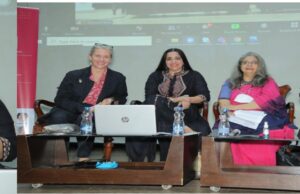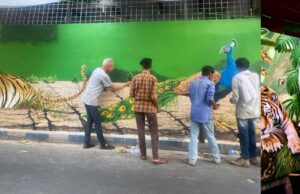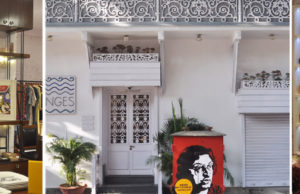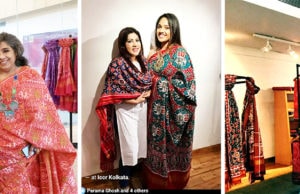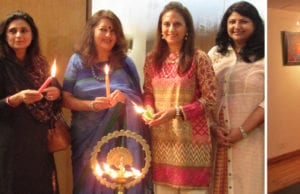
WoT's Hot
Bengal is known for its skilled and dexterous craftsmen and this is reflected in the workmanship of the craft of the State. Many of these crafts are deep rooted in village traditions and have evolved for entertainment purposes. Visiting Kolkata and not checking out some of them would leave your trip incomplete. So here are some 'must see & must buy' craft list of West Bengal. And if you are enthusiastic you can even visit some of the craft villages.
Pattachitras – village bioscope
A folk version of a modern story board, Pattachitras are painted narrative scrolls by groups of itinerant singing storytellers of Medinpur. These stylized paintings in natural pigments on pat (cloth) layered with paper depict lives of rural and folk Bengal. The patuas, (artists) travel villages narrating the tales on the pat with songs and drama. More than just a form of village bioscope, pats are powerful tools of communication and you can find pat on the perils of AIDS and against girl child infanticide, it all depends on the sensitivity of the artist.
The craft has been adapted to make attractive utility products like, sara (plates), painted cane boxes, T-shirts and wooden spoons.
Santiniketan Batik – a popular urban craft
Early 20th century Bengal saw a resurgence of local folk crafts in Santiniketan as creative practical learning was given priority in this institution; amongst these were batik and kantha. Perhaps the only urban craft to have gained the popularity it has, this resist dye technique from the Far East became quite a hit in its time; sarees with the typical alpana motifs of Bengal in batik was considered fashionable. After the initial excitement it was found the craft was stagnating, but in the past few years it has had a new lease on life with technical and design interventions, and beautiful wall panels, stylish sarees, scarves, yardage and eye catching accessories in vegetable dyes, is quite a rage again now.
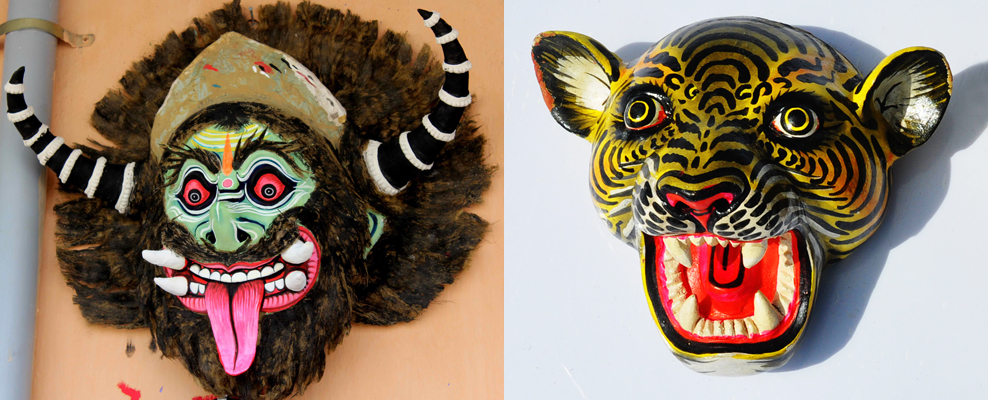
Purulia Chhau Mask:
For a first timer viewing a performance of the martial Chhau dance can be a bit intimidating! The dancers in huge fearful masks with additional headgear – the largest can be 5 ft in dia - depicting Gods, Goddesses and mythological characters charging towards you at the roll of the drum and shennai can quiver the bravest of hearts! Bright and colourful, you will find families after families making these masks in Chorida, in Purulia district of West Bengal. The clay base of the masks are layered with paper and finally painted and decorated with tinsel according to the character being depicted. Forceful and over powering, the masks make quite a conversation point in your living room.
Leather Batik:
The renowned artist Nandalal Bose, adapted batik to leather, in Sriniketan under the Amar Kutir Society for Rural Development at Santiniketan developing a craft that is now recognized as quintessentially from here and no other.
These hand painted and embossed leather accessories in geometrical designs and folk motifs use bright vegetable colours, giving these products a sophisticated appeal. Traditional objects include handbags, pouches, murras (poufs), footwear etc. With design intervention the craft has been adapted for high end fashion accessories and fun products, like auto-rickshaw and double-decker bus shaped pouches and boxes, which are quite the collectible.
Cane and Bamboo Craft – cool mats of Mednipur
Cool mats, sounds ‘cool’ and they are! Made from cane strips and Murtal leaves, Sital Pati – meaning ‘cool-mats’ are what you need in the hot humid weather of West Bengal. Mats with dyed strips and woven designs are called Nakshi Patti. Cooch Behar and Bankura districts of the State have an abundance of various species of cane and Murta plants. Woven cane basketry, wooden masks and wall carvings are the other popular crafts from this region.
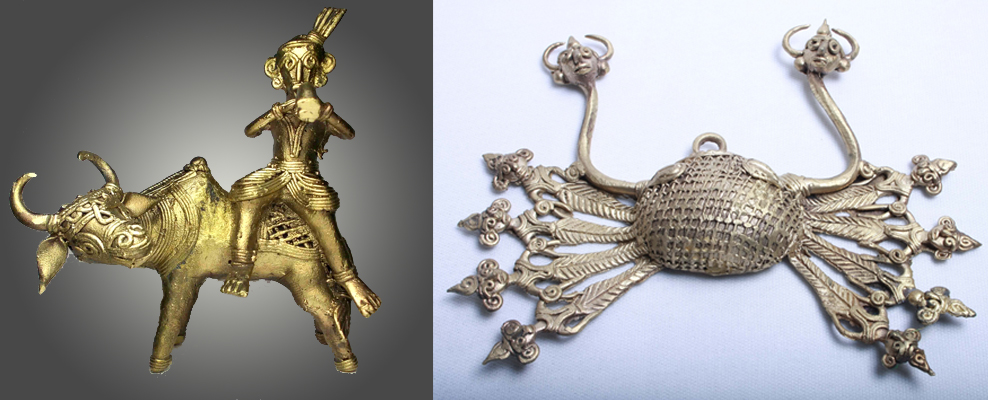
Dokra – the ultimate juggad
The ultimate jugaad made into fine art must be Dokra, - the lost wax technique of metal castings of the Dokra Damar tribe. In India the most famous example of this craft is the dancing girl of Mohenjodaro. Traditionally Dokra craftsmen travelled between villages, offering their service to make something new out of old utensils and metal pieces. They would hustle up trinkets, boxes, bowls and other utility products and decorative pieces; their inherent artistic skills adding a new dimension to ordinary household objects. In Bengal, a large cluster lives in Bikna on the outskirts of Bankura where you will find them singing the stories behind their beautiful craft as they create them.
For modern use, the craft has been adapted in making door handles, knobs, book ends, containers and more.
Jute – the golden fiber
The history of the 'golden fiber' is interlinked with the political history of the state. With the partition the Jute manufacturing units in West Bengal were cut off from the plantations in the Gangetic swamp lands of erstwhile East Pakistan, killing the industry overnight! You will find ghostly evidence of this one time flourishing trade, if you drive down the river front of Kolkata, in dilapidated and padlocked old Jute mills. The other factor was plastic. When woven plastic bags replaced jute in the packaging industry it was the final coffin nail. To save the craft the Govt. introduced it in cottage industry and it adapted quite well. Today you get a wide choice in Jute products ranging from high-end jute-blended carpets, furnishing materials, tapestries, colorful hand bags, bedspreads and more.
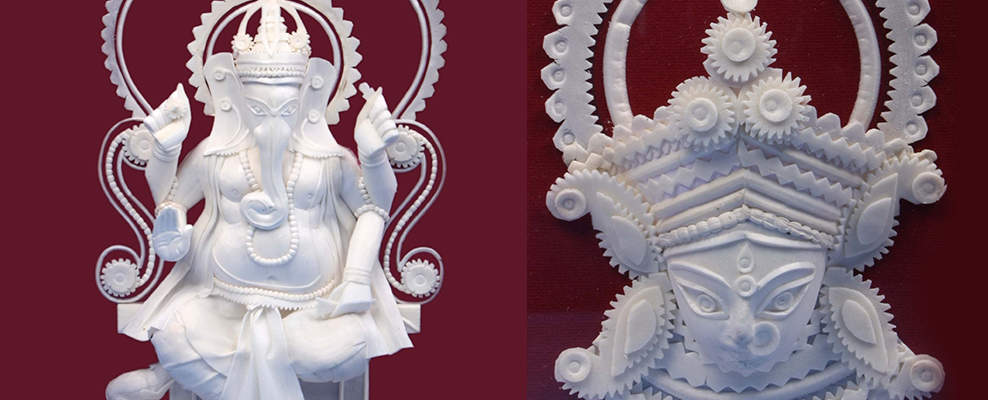
Shola Pith - the Indian cork
If you have a Malakar friend chances are his forefathers were Shola Pith craftsmen. Malakars (garland makers) were florists, supplying flowers and decorations to homes during festival. They used the soft lustrous inner portion of the Shola Pith plant for making decorations for deities – remember the ethereal sholar sajer Durga - and the Bengali grooms’ topor (conical wedding hat) and mukut (crown) for the bride. Being soft and pliant, the material also works well in sculpting. Intricately carved, Goddess Durga’s bust, chariots, boats and more are made in Sholapith, and these make exquisite showpieces.
Terracotta – art of burnt clay
The terracotta temples of Bishnupur highlight Bengal’s expertise in terracotta craft. The fine laterite soil of the region and the Gangetic fine clay - poli-mati - that are commonly used result in two different coloured terracotta, reddish and beige respectively. Alternating the two for creative purpose has been experimented with by modern day terracotta artists. Terracotta pots, sara, (plates), bowls etc were once used in abundance in Bengal and even now chai in a terracotta khulhads at a roadside dhaba add an earthy flavour to the beverage. You can buy decorative vases, finely crafted life-like figurines and attractive utility products in terracotta, in most craft shops in the city.
Dashabatar Cards - a royal card game
It was a game fit for the royals! The Dashabatar taash or the Dashabatar Ganjifa, as it is also known - are made of pasted treated fabric and hand painted depicting the ten avatars of Vishnu. A complete set consists of 120 cards. A complicated five player game was once played by the Nawabs of Bishnupur using these cards, until few centuries ago. Though the game has discontinued these intricately painted round cards have evolved as much sought after collectibles.
Save Save SaveBengal is known for its skilled and dexterous craftsmen and this is reflected in the workmanship of the craft of the State. Many of these crafts are deep rooted in village traditions and have evolved for entertainment purposes. Visiting Kolkata and not checking out some of them would leave your trip incomplet
Other Articles in Kolkata & Bengal
What to read next
Featured articles

Welcome Festive Season in Glam, Latin Quarters Launches new #PujoBling Collection with Monami Ghosh
by WOT




































